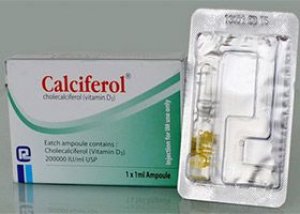
All iLive content is medically reviewed or fact checked to ensure as much factual accuracy as possible.
We have strict sourcing guidelines and only link to reputable media sites, academic research institutions and, whenever possible, medically peer reviewed studies. Note that the numbers in parentheses ([1], [2], etc.) are clickable links to these studies.
If you feel that any of our content is inaccurate, out-of-date, or otherwise questionable, please select it and press Ctrl + Enter.
Calciferol
Medical expert of the article
Last reviewed: 03.07.2025

Calciferol is better known as vitamin D and is a biologically active substance. It was discovered by accident, from observations of dogs it emerged that those fed fish oil did not suffer from rickets. At first, such an effect was attributed to vitamin A, then, having neutralized it in a portion of fish oil, they were convinced that the medicinal properties were preserved and the dog recovered. This was the fourth vitamin discovered, so it was named after the corresponding letter of the alphabet. It is synthesized under the influence of ultraviolet rays (vitamin D3) or comes with food (D2). It is contained in the following foods: fatty fish (salmon, cod), seaweed, caviar, butter, cheese, yeast. Vitamin D deficiency is eliminated with the help of the pharmacy drug calciferol.
 [ 1 ]
[ 1 ]
ATC classification
Active ingredients
Pharmacological group
Pharmachologic effect
Indications Calciferol
Indications for the use of calciferol are the prevention and treatment of osteoporosis. It is prescribed for fractures, during the period of intensive growth of children, with a lack of external intake into the body.
 [ 2 ]
[ 2 ]
Pharmacodynamics
The main task of calciferol is to promote the absorption of calcium and phosphorus entering the human body from food. It has been proven that it takes part in the regulation of cell division, metabolic processes, and the production of a number of hormones. It affects bone density, making it stronger, and is involved in blood clotting processes. Its effectiveness in preventing diseases such as respiratory, cardiovascular, obesity, prostate and breast cancer is also known.
Pharmacokinetics
The pharmacokinetics of the drug is determined by the fact that vitamin D is actually a provitamin. It is absorbed in the small intestine, and to start its transport mechanism, by which calcium is absorbed, it is first converted in the liver into calcidiol, then in the kidneys into calcitriol. It is excreted from the body mainly by the kidneys.
Use Calciferol during pregnancy
The name calciferol means "carrying calcium", and it is on this property that the need to use it during pregnancy is based. Vitamin D contributes to the formation of the child's skeleton, maintains the mother's skeletal system in a normal state, and prevents damage to teeth. In fact, the role of calciferol is much more significant and complex than replenishing the body with calcium. It is necessary for the implementation of important vital functions, so a decrease in its concentration entails significant disruptions in the health of the expectant mother and baby. The most dangerous is the development of rickets. The first symptoms appear already in the second month of the child's life: increased nervous excitability, poor sleep, a sharp reaction to touch, bright light, loud sounds. In such children, the ossification process slows down, so weight gain entails curvature of the spine and legs. To avoid such pathologies, pregnant and nursing mothers are prescribed this drug. Its dose should not exceed 600 IU of vitamin D3 and 1500 mg of calcium.
Contraindications
Contraindications to the use of calciferol include hypersensitivity to the components of the drug, as well as a number of diseases. These include: primary or secondary hypercalcemia - pathology of the endocrine system, hypercalciuria - excessive excretion of calcium in the urine, the presence of kidney stones, malignant tumors in the bone marrow, bone metastases, sarcoidosis, renal failure, osteoporosis, in which a person is immobile. The drug is not prescribed to children under 8 years of age.
Overdose
An overdose of calciferol can lead to an excess of vitamin D, which is fraught with an increase in the level of calcium in the body. When taking the drug, it is necessary to take into account its intake from food sources. An overdose is manifested by fever, difficulty breathing, slow pulse, nausea and vomiting, weakness, sweating, malaise, discomfort in the digestive organs. Muscle and joint pain, cramps are possible. Excessive thirst and frequent urge to urinate indicate problems with the kidneys. In this case, it is necessary to introduce a large amount of fluid into the body and use diuretics, steroid hormones, calcitonin, which is involved in calcium metabolism, bisphosphonates in order to prevent metabolic disorders.
 [ 20 ]
[ 20 ]
Interactions with other drugs
Interactions with other drugs are different and depend on the group of drugs. Thus, simultaneous administration with phenytoin (antiepileptic drug) or barbiturates reduces the activity of vitamin D3. When taking cardiovascular glycoside drugs, an electrocardiogram should be monitored, since calciferol dynamizes their action, and tetracyclines are better absorbed from the gastrointestinal tract, so they are taken at intervals of 3 hours. The combined use of sodium fluoride or bisphosphonates with vitamin D leads to worse absorption of the former, the time difference in this case should be at least 2 hours. Glucocorticoids, loop diuretics, laxatives reduce calcium content, and therefore increase the dose of the vitamin. Simultaneous administration of thiazide diuretics, on the contrary, can lead to hypercalcemia.
Manufacturer
Attention!
To simplify the perception of information, this instruction for use of the drug "Calciferol" translated and presented in a special form on the basis of the official instructions for medical use of the drug. Before use read the annotation that came directly to medicines.
Description provided for informational purposes and is not a guide to self-healing. The need for this drug, the purpose of the treatment regimen, methods and dose of the drug is determined solely by the attending physician. Self-medication is dangerous for your health.

